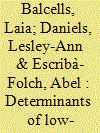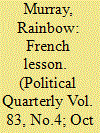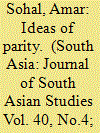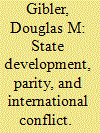|
|
|
Sort Order |
|
|
|
Items / Page
|
|
|
|
|
|
|
| Srl | Item |
| 1 |
ID:
143322


|
|
|
|
|
| Summary/Abstract |
What accounts for low-intensity intergroup violence? This article explores the determinants of low-intensity sectarian violence in Northern Ireland, which has marked the post-1998 peace agreement period. Low-intensity violence comprises a variety of events from riots to attacks against other civilians as well as against homes and symbolic buildings such as churches. We argue that this violence is more likely and prevalent in interface areas where similarly sized rival communities are geographically in contact with each other. Parity and contact spur intergroup competition and threat perception, and they increase the viability of violence. We use original cross-sectional time-series violence data for the 2005–12 period at a disaggregated subnational level, the ward, and a wide variety of social and economic indicators to test our hypotheses. In particular, we assess the impact of within-ward ethnic composition, on the one hand, and the ethnic composition of neighboring wards, on the other. We find that the number of intergroup violent events peaks in wards where there is parity between groups, and in predominantly Catholic (Protestant) wards that border predominantly Protestant (Catholic) wards. The article makes two main contributions: it shows that micro-level dynamics of violence can expand beyond local territorial units, and it suggests that ethnic segregation is unlikely to prevent intergroup violence.
|
|
|
|
|
|
|
|
|
|
|
|
|
|
|
|
| 2 |
ID:
118227


|
|
|
|
|
| Publication |
2012.
|
| Summary/Abstract |
France and the UK both have parliaments with one MP per constituency. This electoral system is known not to be conducive to women's representation, and both countries have struggled with low proportions of women in parliament. France's response was to introduce a gender parity law in 2000. Since then, the number of women in the French parliament has almost doubled, but still remains low by European standards and is far from parity. This article considers what the UK can learn from the French experience. In particular, it considers how gender quotas emerged onto the agenda in France, why they were set at 50% and how effective this was, how they were implemented, and why they have not been more successful. The article does not recommend following in France's footsteps, but the UK can take inspiration from France's successes and seek to avoid repeating her mistakes.
|
|
|
|
|
|
|
|
|
|
|
|
|
|
|
|
| 3 |
ID:
157084


|
|
|
|
|
| Summary/Abstract |
Historians have suggested that the politics of late colonial India centred on a battle between two discrete ideas: Indian and Muslim nationalism. Complicating this binary, this paper focuses on three conceptions of parity between religious groups, contending that this logic transcended Mohammad Ali Jinnah's and the Muslim League's call for constitutional equality between Hindus and Muslims to shape a wider debate about how to defy communal majoritarianism and exit identity politics altogether. Just as Jinnah sought to prevent Hindu dominance within a single state, the Akali Sikhs—influenced as much by a negative historical imagination as the contemporary logic of numbers—produced their own constitutional claim in order to avert Muslim supremacy in the Punjab. Meanwhile Maulana Abul Kalam Azad, president of the Indian National Congress between 1940 and 1946, posited a unique thesis: since modern India was the joint construction of Hindus and Muslims, parity already existed. Though he held that Jinnah's call for constitutional parity was consequently superfluous, Azad's idea of the shared nation led him to search for a genuine consensus, rather than a simple truce, between India's two major political parties. This paper argues that the 1946 Cabinet Mission Plan, offering a degree of parity between communities whilst retaining Indian unity, represented the near-realisation of these three ideas.
|
|
|
|
|
|
|
|
|
|
|
|
|
|
|
|
| 4 |
ID:
153761


|
|
|
|
|
| Summary/Abstract |
This article explains the empirical connection between dyadic capability differences and international conflict as a consequence of how, when, and where states enter the international system. State capabilities are largely static, and, since states enter the system in geographic clusters, the processes of state maturation affect contiguous and regionally proximate states similarly. This makes dyadic capability differences static as well. The lack of change in capability differences over time suggests that the parity-conflict relationship is largely a product of the factors associated with state system entry. Indeed, as I demonstrate, several different proxies for the conditions of state system entry separately eliminate any statistical relationship between parity and militarized dispute onset, 1816–2001. I also find no relationship between parity and the wars that have occurred during that same time period. These results have a number of implications for the role of power and capabilities in explaining international conflict.
|
|
|
|
|
|
|
|
|
|
|
|
|
|
|
|
|
|
|
|
|